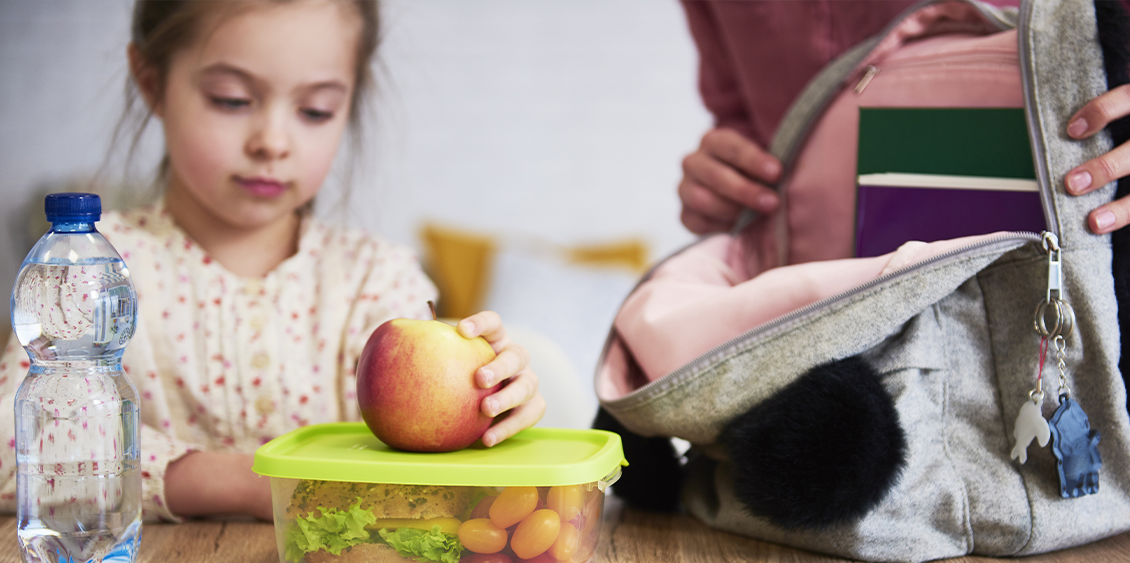Back-to-school season means back to packing lunches—something few parents look forward to. A lack of ideas or time, food allergies, and picky eaters can make it tricky to provide a good variety of healthy, appetizing lunches. Suffice to say that making five lunches a week that tick every box is no easy task!
Read on for simple ideas on how to make deliciously healthy lunches that toddlers, teens, and even busy grownups will enjoy.

How to make a healthy lunchbox
According to Canada’s Food Guide a healthy lunch box should contain:
- 50% fruit and vegetables
- 25% animal or plant-based protein
- 25% whole grains
- Water as the main beverage
These proportions ensure balanced energy intake for better concentration and fewer afternoon cravings.
Healthy lunches can include a variety of different foods
- Fruits and vegetables: apples, clementines, melons, grapes, carrots, peppers, edamame, cucumbers, etc.
- Protein: meat, fish, hard-boiled eggs, lentils, chickpeas, Greek yogurt, tofu cubes, etc.
- Whole grains: multi-grain bread, whole-wheat bagel, tortilla, brown rice, couscous, quinoa, etc.
- Snacks: trail mix (nuts and dried fruit), unsweetened applesauce, homemade energy ball, carrot muffin, etc.
- Drink: water or homemade infused water (cucumber, mint, strawberry, etc.)
Foods to avoid
- Sweetened beverages (juices, soft drinks, energy drinks): These not only offer little nutritional value, they’re often high in refined sugar, which can hinder concentration and increase mid-afternoon fatigue.
- Chips and other salty snacks: These are often high in sodium and fat, and low in fiber and essential nutrients.
- Commercial cold cuts (salami, pepperoni, sliced ham, etc.): Forego overly salty, additive-laden cold cuts for simpler proteins, such as grilled chicken or eggs.
- Ultra-processed granola bars: They may be convenient, but they’re often low in fiber and high in sugar and artificial additives.
- Commercially prepared sweets and baked goods (cake, cookies, candy, etc.): Save these low nutritive value treats for special occasions, such as Halloween or birthday parties.
- Foods with trans fats or saturated fats: Saturated and trans fats are often found in processed or ready-to-eat foods. They can be harmful to long-term cardiovascular health.
In short, simple, unprocessed, easy-to-digest foods are your best bet.
Lunch tips to keep things interesting
Eating better every day can be as easy as making a few basic changes. No need to make things complicated! Last night’s leftovers are a simple choice for a healthy lunch: a mild curry, stir-fried rice with vegetables, or a hearty soup are all perfect for a lunch box.
Shake up the routine with with a few new sandwich ideas: try a chicken tortilla wrap, bagel with cream cheese and raw veggies, pita with homemade falafel... the sky’s the limit!
A deconstructed lunch is also a fun way to spice up your afternoon. Packed in a lunch box with compartments, this playful approach offers a variety of foods that are easy to put together and eat. For example: raw vegetables and dip, a few whole-grain crackers, cheese cubes, a handful of nuts, and pieces of fresh fruit. It’s a colourful, nutritious lunch that’s easy to adapt to individual tastes!
Here are three healthy vegetarian recipes for the whole family to enjoy!
Grownup healthy lunch idea: salad on the go
Ingredients (4 servings)
- Cooked quinoa (1 cup)
- Edamame (1 cup)
- Cherry tomatoes, halved (1 cup)
- Mango, diced (1 cup)
- Roasted sweet potato cubes (1 cup)
- Red onion, thinly sliced (¼ cup)
- Baby spinach (1 cup)
- Sharp cheddar, grated (½ cup)
- Light dressing, to taste (e.g., yogurt, lemon and herbs)
Instructions
- Combine all ingredients in a bowl.
- Refrigerate.
- Add dressing just before serving.
Kids’ healthy lunch idea: veggie quesadilla
Ingredients (2 quesadillas/4 servings)
- Same ingredients as for the previous recipe
- 4 whole wheat tortillas
- Grated cheese (sharp cheddar or mild mozzarella)
Instructions
- Combine all ingredients except tortillas and cheese in a food processor and blend until finely minced.
- Heat a non-stick frying pan over medium heat.
- Place one tortilla in the pan and sprinkle with grated cheese.
- Spread a few spoonfuls of the veggie mixture on top.
- Add a bit more cheese, then cover with a second tortilla.
- Cook for about 2–3 minutes on each side, until the tortilla is golden brown and the cheese is melted.
- Cut into triangles so they're easy to hold.
Healthy side dish idea for everyone: cinnamon-cocoa energy balls
Ingredients (12 to 14 balls)
- Almonds (1 cup)
- Unsweetened coconut (½ cup)
- Cocoa powder (¼ cup)
- Ground cinnamon (½ tsp.)
- Vanilla extract (½ tsp.)
- Pinch of salt
- Pitted Medjool dates (1 cup)
Instructions
- In a food processor, blend almonds, coconut, cocoa, cinnamon, vanilla, and salt to a granular texture.
- Add the dates and blend until the mixture is smooth and easy to handle.
- Shape into balls with your hands.
- Store in an airtight container in the refrigerator. Extras can be frozen to enjoy over the next few weeks.
Inviting children to help is key
Inviting children to help out with lunch prep is a great way to teach them about healthy food and encourage them to take an interest in what they eat, while respecting their food preferences and empowering them at the same time. There’s a better chance that they’ll finish their lunches, thus reducing food waste.
Even the littlest ones can do small but important tasks, such as washing vegetables, filling a dip container, or selecting a fruit for their lunch box. The more your children participate, the more likely they are to develop healthy eating habits long-term.
A healthy lunch deserves the right container
A good-quality lunch not only includes good food, but also the right container! Good-quality lunch boxes help keep food fresh, appetizing, and easy to eat, especially for little hands.
Best materials:
- Stainless steel
- Food grade silicone
- Tempered glass
- Certified Bisphenol A (BPA)- and phthalate-free food grade plastic
- Polypropylene
Materials to avoid:
- Plastics that contain BPA
- Soft plastics that contain phthalates
- Polystyrene foam (styrofoam)
- Polyvinyl chloride (PVC)
- Uncoated or non-anodized aluminum.
Opt for sturdy containers that are easy to wash and safe to use.
More ideas to streamline your week
- Prepare raw vegetables, fruit, and snacks over the weekend.
- Cook double the normal amount for supper so there’s enough left over for lunch the next day.
- Freeze portions of soup, chili, or stew for busier weeks.
- Designate refrigerator space for ready-to-grab lunch boxes.
- Post a chart of the week’s lunches where everyone can see it.
- Fill water bottles and baggies the night before.
- Keep healthy snacks on hand (applesauce, nuts, crackers, etc.).
Healthy, tasty, and easy
Make child’s play of weekly healthy lunches! Keep the menu fresh and fun with a bit of planning, a good variety of healthy ingredients, and a dash of creativity. Inviting children to participate, re-purposing leftovers, and using the right containers can help streamline your routine and make lunch box meals more balanced, colourful, and appetizing. Eating well doesn’t have to be complicated!
Looking for personalized nutrition advice?
Our nutrition specialists are here to help!
More articles that might interest you
Breakfast ideas: quick and simple recipes for the morning rush

